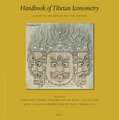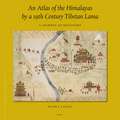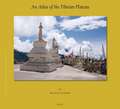Ethnolinguistic Prehistory of the Eastern Himalaya: Brill's Tibetan Studies Library, cartea 52
Editat de Mark W. Post, Stephen Morey, Toni Huberen Limba Engleză Hardback – 10 aug 2022
This pioneering interdisciplinary volume brings together a diverse group of linguists and anthropologists, all of whom seek to reconstruct aspects of Eastern Himalayan ethnolinguistic prehistory from an empirical standpoint, on the basis of primary fieldwork-derived data from a diverse range of Himalayan Indigenous languages and cultural practices.
Contributors are: David Bradley, Scott DeLancey, Toni Huber, Gwendolyn Hyslop, Linda Konnerth, Ismael Lieberherr, Yankee Modi, Stephen Morey, Mark W. Post, Uta Reinöhl, Alban Stockhausen, Amos Teo, and Marion Wettstein .
Din seria Brill's Tibetan Studies Library
- 18%
 Preț: 973.52 lei
Preț: 973.52 lei - 15%
 Preț: 499.07 lei
Preț: 499.07 lei - 18%
 Preț: 807.63 lei
Preț: 807.63 lei - 18%
 Preț: 905.92 lei
Preț: 905.92 lei - 18%
 Preț: 1003.18 lei
Preț: 1003.18 lei - 18%
 Preț: 739.90 lei
Preț: 739.90 lei - 18%
 Preț: 684.38 lei
Preț: 684.38 lei - 18%
 Preț: 533.41 lei
Preț: 533.41 lei - 18%
 Preț: 720.69 lei
Preț: 720.69 lei - 18%
 Preț: 929.04 lei
Preț: 929.04 lei - 18%
 Preț: 717.98 lei
Preț: 717.98 lei - 18%
 Preț: 716.80 lei
Preț: 716.80 lei - 18%
 Preț: 588.27 lei
Preț: 588.27 lei - 18%
 Preț: 905.05 lei
Preț: 905.05 lei - 18%
 Preț: 1848.82 lei
Preț: 1848.82 lei - 18%
 Preț: 705.38 lei
Preț: 705.38 lei - 18%
 Preț: 686.92 lei
Preț: 686.92 lei - 18%
 Preț: 689.47 lei
Preț: 689.47 lei - 18%
 Preț: 833.52 lei
Preț: 833.52 lei - 18%
 Preț: 721.37 lei
Preț: 721.37 lei - 18%
 Preț: 728.09 lei
Preț: 728.09 lei - 18%
 Preț: 853.29 lei
Preț: 853.29 lei - 18%
 Preț: 605.09 lei
Preț: 605.09 lei - 18%
 Preț: 606.42 lei
Preț: 606.42 lei - 18%
 Preț: 571.12 lei
Preț: 571.12 lei - 18%
 Preț: 918.05 lei
Preț: 918.05 lei - 18%
 Preț: 633.55 lei
Preț: 633.55 lei - 18%
 Preț: 1117.76 lei
Preț: 1117.76 lei - 18%
 Preț: 959.87 lei
Preț: 959.87 lei - 18%
 Preț: 815.02 lei
Preț: 815.02 lei - 18%
 Preț: 606.10 lei
Preț: 606.10 lei - 5%
 Preț: 707.13 lei
Preț: 707.13 lei - 18%
 Preț: 549.50 lei
Preț: 549.50 lei - 18%
 Preț: 587.23 lei
Preț: 587.23 lei - 18%
 Preț: 594.00 lei
Preț: 594.00 lei - 18%
 Preț: 526.38 lei
Preț: 526.38 lei - 18%
 Preț: 626.06 lei
Preț: 626.06 lei - 15%
 Preț: 499.43 lei
Preț: 499.43 lei - 18%
 Preț: 753.78 lei
Preț: 753.78 lei - 18%
 Preț: 585.70 lei
Preț: 585.70 lei - 18%
 Preț: 608.95 lei
Preț: 608.95 lei - 15%
 Preț: 479.01 lei
Preț: 479.01 lei - 18%
 Preț: 723.01 lei
Preț: 723.01 lei - 18%
 Preț: 1057.38 lei
Preț: 1057.38 lei - 18%
 Preț: 701.98 lei
Preț: 701.98 lei
Preț: 660.72 lei
Preț vechi: 805.76 lei
-18% Nou
Puncte Express: 991
Preț estimativ în valută:
126.43€ • 132.34$ • 105.23£
126.43€ • 132.34$ • 105.23£
Carte indisponibilă temporar
Doresc să fiu notificat când acest titlu va fi disponibil:
Se trimite...
Preluare comenzi: 021 569.72.76
Specificații
ISBN-13: 9789004513136
ISBN-10: 9004513132
Pagini: 400
Dimensiuni: 155 x 235 mm
Greutate: 0 kg
Editura: Brill
Colecția Brill
Seria Brill's Tibetan Studies Library
ISBN-10: 9004513132
Pagini: 400
Dimensiuni: 155 x 235 mm
Greutate: 0 kg
Editura: Brill
Colecția Brill
Seria Brill's Tibetan Studies Library
Notă biografică
Mark W. Post is a linguist specialising in the grammars, prehistories and sustainability of Asia’s Indigenous languages. He is author/editor of nine books including The Tangam Language, A Galo-English Dictionary and Language and Culture in Northeast India and Beyond, as well as the North East Indian Linguistics book series (v. 1-5). Currently Senior Lecturer in Linguistics at the University of Sydney, he is also Co-Director (together with Yankee Modi) of the Centre for Cultural-Linguistic Diversity (Eastern Himalaya), an organization dedicated to community-led documentation and maintenance of Asia’s Indigenous languages.
Stephen Morey is an Associate Professor in the Department of Languages and Linguistics at La Trobe University. He is the author of two books (and multiple articles) on tribal languages in Assam, from both Tai-Kadai and Tibeto-Burman families. His research work has been on language documentation with a particular focus on traditional songs and ritual language. He is the secretary of the North East Indian Linguistics Society and has been co-editor for all 8 volumes of the series North East Indian Linguistics. He also researches and has written on the Aboriginal languages of Victoria, Australia, work that has involved research into 19th century manuscript collections in libraries around Australia and overseas, and also involves collaboration with community members.
Toni Huber is Professor of Tibetan Studies at the Humboldt University of Berlin. His principal research fields cover ritual and religion in communal life, hunting and attitudes towards wildlife, the culture of pilgrimage and sacred landscapes. His nine books and many other publications on the anthropology and cultural history of Tibetan and Himalayan societies include The Cult of Pure Crystal Mountai, The Holy Land Reborn, Origins and Migrations in the Extended Eastern Himalaya, and Source of Life: Revitalisation Rites and Bon Shamans in Bhutan and the Eastern Himalayas (2 vols.).
Stephen Morey is an Associate Professor in the Department of Languages and Linguistics at La Trobe University. He is the author of two books (and multiple articles) on tribal languages in Assam, from both Tai-Kadai and Tibeto-Burman families. His research work has been on language documentation with a particular focus on traditional songs and ritual language. He is the secretary of the North East Indian Linguistics Society and has been co-editor for all 8 volumes of the series North East Indian Linguistics. He also researches and has written on the Aboriginal languages of Victoria, Australia, work that has involved research into 19th century manuscript collections in libraries around Australia and overseas, and also involves collaboration with community members.
Toni Huber is Professor of Tibetan Studies at the Humboldt University of Berlin. His principal research fields cover ritual and religion in communal life, hunting and attitudes towards wildlife, the culture of pilgrimage and sacred landscapes. His nine books and many other publications on the anthropology and cultural history of Tibetan and Himalayan societies include The Cult of Pure Crystal Mountai, The Holy Land Reborn, Origins and Migrations in the Extended Eastern Himalaya, and Source of Life: Revitalisation Rites and Bon Shamans in Bhutan and the Eastern Himalayas (2 vols.).
Cuprins
List of Tables, Figures and Maps
Introduction: Ethno-linguistic Prehistory of the Eastern Himalaya: Diversity and Its Sources
Mark W. Post, Stephen Morey and Toni Huber
2 Reconsidering Zomia from an Eastern Himalayan Perspective
Mark W. Post
3 The Prehistory of Tangsa as Recorded in Traditional Songs and Stories
Stephen Morey
4 Ethnographic Comparison and Pre-history? A Comparison of Chamdam Status Rituals among the Dumi Rai of Eastern Nepal and the Feasts of Merit among the Ao Naga of Northeast India
Marion Wettstein and Alban Stockhausen
5 Principles of Naming in the Eastern Himalaya: What Can They Tell Us about Prehistory?
Yankee Modi
6 Puroik Sago Terminology
Ismael Lieberherr
7 Phylogeny of Tibeto-Burman from Plants and Animals
David Bradley
8 Pre-modern Language Contact in Nagaland
Amos Teo
9 Locating Kera’a (Idu Mishmi) in Its Linguistic Neighbourhood: Evidence from Dialectology
Uta Reinoehl
10 First Person Pronominals in Kuki-Naga
Scott DeLancey
11 Sound Changes from Proto-South-Central (“Proto-Kuki-Chin”) to Monsang and Their Implications for the Classification of the Northwestern Languages within the South-Central Branch
Linda Konnerth
12 Kurtöp Verbal Morphology in the East Bodish Context: A Case Study in Ethnohistorical Morphosyntax?
Gwendolyn Hyslop
Introduction: Ethno-linguistic Prehistory of the Eastern Himalaya: Diversity and Its Sources
Mark W. Post, Stephen Morey and Toni Huber
Part 1 Cultural Practice and Prehistory
2 Reconsidering Zomia from an Eastern Himalayan Perspective
Mark W. Post
3 The Prehistory of Tangsa as Recorded in Traditional Songs and Stories
Stephen Morey
4 Ethnographic Comparison and Pre-history? A Comparison of Chamdam Status Rituals among the Dumi Rai of Eastern Nepal and the Feasts of Merit among the Ao Naga of Northeast India
Marion Wettstein and Alban Stockhausen
5 Principles of Naming in the Eastern Himalaya: What Can They Tell Us about Prehistory?
Yankee Modi
6 Puroik Sago Terminology
Ismael Lieberherr
Part 2 Language and Prehistory
7 Phylogeny of Tibeto-Burman from Plants and Animals
David Bradley
8 Pre-modern Language Contact in Nagaland
Amos Teo
9 Locating Kera’a (Idu Mishmi) in Its Linguistic Neighbourhood: Evidence from Dialectology
Uta Reinoehl
10 First Person Pronominals in Kuki-Naga
Scott DeLancey
11 Sound Changes from Proto-South-Central (“Proto-Kuki-Chin”) to Monsang and Their Implications for the Classification of the Northwestern Languages within the South-Central Branch
Linda Konnerth
12 Kurtöp Verbal Morphology in the East Bodish Context: A Case Study in Ethnohistorical Morphosyntax?
Gwendolyn Hyslop
